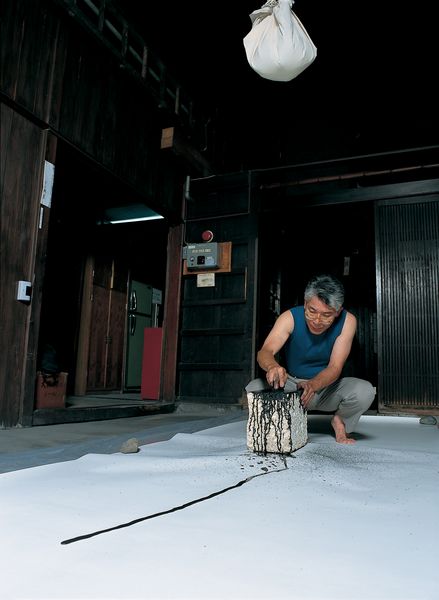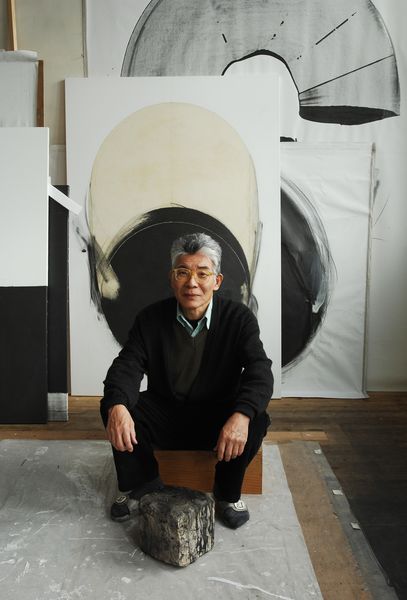Family Saturday at Home: Experimenting with Gutai

Takesada Matsutani, Three Circles - 19, 2019, vinyl adhesive, acrylic, graphite pencil on canvas, 55 x 38 x 3.5 cm / 21 5/8 x 15 x 1 3/8 in. Photo: Studio Matsutani
Family Saturday at Home: Experimenting with Gutai
On the occasion of his online exhibition ‘Stream’, this ‘Family Saturday at Home’ is inspired by artist Takesada Matsutani. Take part in our popular Family Saturdays from the comfort of home with a series of creative, hands-on activities to enjoy together with your children. These are aimed at 6+ but can be easily adapted and guided for younger children.


About Takesada Matsutani
From the early 1960s to the early 1970s, Takesada Matsutani was a key member of the Gutai Art Association (1954 – 1972), Japan’s innovative and influential art collective of the post-war era. Inspired by blood samples he had viewed under a microscope, Matsutani began to develop his signature style of circular, bubble-like forms from blobs of vinyl glue that he deposited on the surfaces of his canvases. By working closely with the material, he embodied an important aspect of Gutai: letting the material and spirit work in conjunction with one another to create something new.
In 1966, Matsutani received a grant from the French government after winning first prize in the 1st Mainichi Art Competition, and subsequently moved to Paris where he continues to live and work. One of the most important Japanese artists still working today, Matsutani continues to demonstrate the spirit of Gutai throughout his practice, conveying the reciprocity between pure gesture and raw material. You can find out more about Takesada Matsutani here.
Activity
You Will Need
Anything that you can find at home and are allowed to use! As part of the Gutai group, Matsutani experimented with vinyl glue, using fans and his own breath to manipulate the substance, creating bulbous and sensuous forms reminiscent of human curves and features. Faithful to his Gutai roots, he strove to identify and convey the essential character of vinyl glue with graphite, that were to become his signature materials. Matsutani began creating vast expanses of metallic black graphite on mural-size sheets of paper built up with painstaking individual strokes. This ritualized manner presents a time-based record of his gestures, while reminiscent of his artistic beginnings in Japan, it has been translated into an artistic language that is uniquely his own.
Activity 1: Soil Pigments
Mix soil with water to create paint.
Collect soil and dirt from your backyard or neighborhood. If you can, sift your dirt to remove any sticks, leaves, or pebbles.
Transfer different amounts of your sifted soil to small jars or cups.
Then, experiment with varying saturation levels of the soil to create different textures and thickness of pigment.
Adding more water to the mixture will create a lighter, liquified pigment similar to watercolor. Adding less water will create a thicker, darker pigment.
Use your hands and fingers to create abstract works on paper, experimenting with the different tones you’ve created with your soil/water composites.
Try to use different types of paper you find around your house like newspaper, tissue paper, cardstock, old postcards, or magazines, to experiment with layering textures.
‘The ink becomes fluid under the combined action of the water and the artist’s repetitive gestures. It starts to drip slowly...’ ‘The idea of a river that is always changing, where each atom is in perpetual motion...’ – Valérie Douniaux, Stream: The Possibilities of Black and White
Activity 2: Tea as a Medium
Try using tea as a medium for an original work on paper.
Steep a tea bag in warm water for 2 min.
Place a piece of paper in your bathtub or on your floor, and suspend the tea bag over the paper.
Try to catch the tea drops below and see what shapes appear on your paper!
Or, lay a row of tea bags on a piece of paper and use a spray bottle to spray water onto the tea bags.
Watch and see how the pigments blend together and trickle down the paper!
Activity 3: Paint With Your Breath
Using watercolors or any other type of paint you have at home, use your breath to blow pigments around your surface. See what types of patterns, color diffusions, and textures you can create, just by blowing the paints around the paper.
We would love to see what you create!
Can you photograph your artwork or ask someone to help you? Here are two easy ways to share your artwork with us: • Tag us on social media using @hauserwirthsomerset (Instagram) or @HWSomerset (Facebook) and use the hashtags #FamilySaturday #HWLearn
For further activities we recommend:
Our artists have created a series of downloadable colouring pages to bring some creativity to your day. Download the ‘ARTatHome’ coloring-in sheet by Takesada Matsutani here.
California African American Museum: Make a pop-up paper house Los Angeles County Museum of Art: Make Art @ Home The Getty: 5 Ideas to Stay Creative With a Pencil and a Piece of Paper Autry Museum of the American West: Distance Learning South London Gallery: Big Family Press Resources Tate: Make a Spin Painting
Family Saturdays have been a popular monthly event at Hauser & Wirth Somerset and Hauser & Wirth Los Angeles. As we embark on our new shared reality, our education team will continue to create activities connected to our exhibitions and artists – encouraging practical hands-on tasks and imaginative narratives to enjoy together as a family.
Resources
1 / 10









